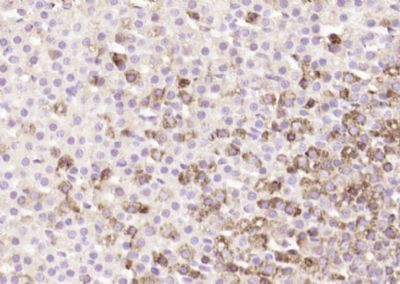KLK15 Polyclonal Antibody
Purified Rabbit Polyclonal Antibody (Pab)
- 产品详情
- 实验流程
Application
| IHC-P, IHC-F, IF, E |
|---|---|
| Primary Accession | Q9H2R5 |
| Reactivity | Rat, Pig, Dog, Bovine |
| Host | Rabbit |
| Clonality | Polyclonal |
| Calculated MW | 28087 Da |
| Physical State | Liquid |
| Immunogen | KLH conjugated synthetic peptide derived from human KLK15 |
| Epitope Specificity | 181-256/256 |
| Isotype | IgG |
| Purity | affinity purified by Protein A |
| Buffer | 0.01M TBS (pH7.4) with 1% BSA, 0.02% Proclin300 and 50% Glycerol. |
| SUBCELLULAR LOCATION | Secreted. |
| SIMILARITY | Belongs to the peptidase S1 family. Kallikrein subfamily.Contains 1 peptidase S1 domain. |
| SUBUNIT | Belongs to the peptidase S1 family. Kallikrein subfamily. Contains 1 peptidase S1 domain. |
| Important Note | This product as supplied is intended for research use only, not for use in human, therapeutic or diagnostic applications. |
| Background Descriptions | The human tissue Kallikrein gene family encodes 15 serine proteases. All Kallikreins share structural similarities including cysteine residues, a catalytic triad of His, Asp, and Ser residues, typically five coding exons, and varied intron phases. Kallikreins are predominantly secreted as inactive zymogens prior to activation by cleavage of an N terminal peptide, and all function extracellularly. Kallikreins can be activated autocatalytically, via other Kallikreins, or additional proteases. While structurally similar, Kallikrein family members have distinct functions and have key roles in many physiological and pathological processes. Many human tissue Kallikreins also show promise as cancer biomarkers, which may facilitate earlier detection and characterization of many forms of cancer. Kallikrein 15 is one of the fifteen kallikrein subfamily members whose gene is located in a cluster on chromosome 19. Increased levels are found in prostate cancer, which indicates its possible use as a diagnostic or prognostic marker for prostate cancer. Four splice variants, each encoding a distinct isoform, have been described. |
| Gene ID | 55554 |
|---|---|
| Other Names | Kallikrein-15, 3.4.21.-, ACO protease, KLK15 |
| Target/Specificity | Highest expression in the thyroid gland. Also expressed in the prostate, salivary, and adrenal glands and in the colon testis and kidney. |
| Dilution | IHC-P=1:100-500,IHC-F=1:100-500,IF=1:100-500,ELISA=1:5000-10000 |
| Format | 0.01M TBS(pH7.4) with 1% BSA, 0.09% (W/V) sodium azide and 50% Glyce |
| Storage | Store at -20 °C for one year. Avoid repeated freeze/thaw cycles. When reconstituted in sterile pH 7.4 0.01M PBS or diluent of antibody the antibody is stable for at least two weeks at 2-4 °C. |
| Name | KLK15 |
|---|---|
| Function | Protease whose physiological substrate is not yet known. |
| Cellular Location | Secreted. |
| Tissue Location | Highest expression in the thyroid gland. Also expressed in the prostate, salivary, and adrenal glands and in the colon testis and kidney. |
Research Areas
For Research Use Only. Not For Use In Diagnostic Procedures.
Application Protocols
Provided below are standard protocols that you may find useful for product applications.
终于等到您。ABCEPTA(百远生物)抗体产品。
点击下方“我要评价 ”按钮提交您的反馈信息,您的反馈和评价是我们最宝贵的财富之一,
我们将在1-3个工作日内处理您的反馈信息。
如有疑问,联系:0512-88856768 tech-china@abcepta.com.
¥ 1,500.00
Cat# AP58338























 癌症的基本特征包括细胞增殖、血管生成、迁移、凋亡逃避机制和细胞永生等。找到癌症发生过程中这些通路的关键标记物和对应的抗体用于检测至关重要。
癌症的基本特征包括细胞增殖、血管生成、迁移、凋亡逃避机制和细胞永生等。找到癌症发生过程中这些通路的关键标记物和对应的抗体用于检测至关重要。 为您推荐一个泛素化位点预测神器——泛素化分析工具,可以为您的蛋白的泛素化位点作出预测和评分。
为您推荐一个泛素化位点预测神器——泛素化分析工具,可以为您的蛋白的泛素化位点作出预测和评分。 细胞自噬受体图形绘图工具为你的蛋白的细胞受体结合位点作出预测和评分,识别结合到自噬通路中的蛋白是非常重要的,便于让我们理解自噬在正常生理、病理过程中的作用,如发育、细胞分化、神经退化性疾病、压力条件下、感染和癌症。
细胞自噬受体图形绘图工具为你的蛋白的细胞受体结合位点作出预测和评分,识别结合到自噬通路中的蛋白是非常重要的,便于让我们理解自噬在正常生理、病理过程中的作用,如发育、细胞分化、神经退化性疾病、压力条件下、感染和癌症。






